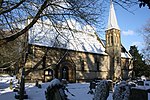Sewerby Hall
1720 establishments in EnglandAC with 0 elementsArt museums and galleries in the East Riding of YorkshireAviariesBridlington ... and 9 more
Country houses in the East Riding of YorkshireGardens in the East Riding of YorkshireGrade I listed buildings in the East Riding of YorkshireGrade I listed housesHistory museums in the East Riding of YorkshireHouses completed in 1720Museums in the East Riding of YorkshireUse British English from September 2019Zoos in England

Sewerby Hall (also known as Sewerby House) is a Grade I listed Georgian country house set in 50 acres (20 ha) of landscaped gardens in the village of Sewerby, 2 miles (3.2 km) from the seaside town of Bridlington in the East Riding of Yorkshire, England. The main block was built circa 1714, incorporating some older work, in 3 storeys in brick with a seven window frontage. In 1808, 2-storey bow fronted wings and a semi-circular Doric portico were added and the whole building painted to resemble stone. The wings were later raised to 3 storeys.
Excerpt from the Wikipedia article Sewerby Hall (License: CC BY-SA 3.0, Authors, Images).Sewerby Hall
Church Lane,
Geographical coordinates (GPS) Address Nearby Places Show on map
Geographical coordinates (GPS)
| Latitude | Longitude |
|---|---|
| N 54.10336 ° | E -0.16095 ° |
Address
Sewerby Hall
Church Lane
YO15 1EA
England, United Kingdom
Open on Google Maps











